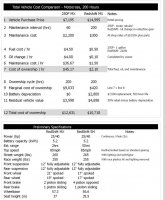Electric cars started in the late 1800's, early 1900's but became surplanted by the ICE.
The difference in battery tech and electronics, is that the batteries didn't become a whole lot better (better, but not leaos and bounds), but the electronics themselves became leaps and bounds better, using less current to do the same function.
The problem is a mid sized sedan, even an aerodynamic one, still needs quite a bit of energy to propel itself at highway speeds. Power density from stable batteries has not improved much, and a HP is 776 watts whether from an engine or a battery.
The range of Electric vehicles in general, remains close to that of 1912.
Buffalo Electric Co. 400 Military Road, Buffalo NY.
1912-1915 Buffalo Electric Vehicle Co.
Founded by Francis A. Babcock, he then formed the Babcock Electric Carriage Co. in 1906. In 1912 his old and new companies merged, along with the Buffalo Automobile Station Co, and the Clark Motor Co. They had Diehl motors, Bevel drive, Philadelphia batteries, and a 100" WB.
1903 A 2 pass Stanhope @ $1,650. Said to go 17 MPH for 50 miles.
1913 A 2 seat roadster and a 4-seat coupe both at $2,600.
We can go alittle faster for 50 miles, but for a variety of reasons, unless you go very exotic in technol0gy both in the electrics and the chassis, 50 miles is still the average range.
The cost is also very high...Which can come down, but a Toyota Corolla basic model is 14K new out the door. Compare that the BRD motorcycle at about the same price.
A corolla has a lot further range, carries more people, cargo. 500 hours at 55 mph is 27500 miles. At $4.00/gal, at 30 mpg, that is $3,700, about half the price of the BRD battery. Sure there is oil changes and maintenance, but the BRD is a single rider machine. And requiring recharging every hour of use is a huge draw back...
Power density in the battery has to increase a huge amount to be viable for the US style of driving, and the recharge infrastructure is not there. Not the recharge station, but the capacity to use a high amp, hi volt recharge, as well as the elecdtric companies ability to provide it. Calif. has brownouts now. Add the extra load, and even if you could charge it quickly, you can't if the grid can't supply you.
Every one of these drawbacks has a good possibility of being addressed, but I don't see it in my lifetime. Just fixing the electric grid capacity is going to be a long time in developing.
Maybe I am pessimistic, but I work in a company that makes cogen products (Gas turbine, fuel cell, steam turbine) that use the waste heat to cool and heat abd being a little intimate with power in the northeast, I don't see it really working.
Places like Manhattan, which is a place the limited range would be ok, has limited power, not only from generating capacity, but infrastructure wiring. Even if capacity doubled in the plants, the underground wiring is old and not up to increased capacity.
I imagine most cities like Boston, Chicago, etc, are up against the same barriers.
I like electric vehicles from a technology, engineering standpoint, and if I had Jay Leno's money and garage, I
would own a few. Since I don't have that, I need the practical, fill it up in 5 minutes and go 3-400 miles on tank convenience. Electric isn't even close to that.






